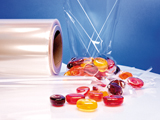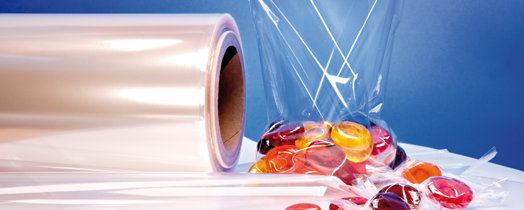02 | 2012 – Plasma technology of the Fraunhofer FEP becoming established in the American packaging market
Transparent packaging films with permeation barrier layers developed by the Fraunhofer FEP are enhancing the freshness of American foods. Moreover, the plasma technology from Dresden has further potential.

„This technology is the best one available today on clear barrier polypropylene packaging films“. Gabriel Durana, Product Manager for Special Technologies at Biofilm S.A. in Mexico, has high praise for the coating technology of the Fraunhofer Institute for Electron Beam and Plasma Technology FEP. In November last year Biofilm commissioned their second plant using the plasma technology from Dresden at its site in Altamira, Mexico. Since starting up the first plant in 2009, Biofilm has supplied the innovative film to manufacturers of snack products and baked goods in North America and Europe. The film has become so popular amongst customers and has opened up new applications, like high-barrier microwavable packaging to give products a freshly-baked taste and feel, that a second production plant became necessary. The new plant is now fully operational and coats films up to 2.85 meters in width.
The vacuum roll-to-roll plants transport the several kilometers long polymer film at speeds of 36 km/h via roller systems through coating stations. Aluminum wire is constantly fed to these stations and is evaporated in hot ceramic crucibles. The trick for applying transparent barrier layers is accurate control of the amount of oxygen that is mixed with the aluminum vapor. To achieve an optimum oxide layer, the oxygen requirement is identified directly by optical measurement systems which detect the transparency of the film and adjust the oxygen feed accordingly. In order to deposit a preferably dense layer on the film, and hence achieve an effective barrier, additional energy is introduced into the aluminum-oxygen vapor in a plasma zone before the vapor hits the substrate. The result is a transparent packaging film with a very thin aluminum oxide layer, which is less permeable for oxygen and water vapor than a conventional film and hence extends the freshness and crispness of foods.
The Fraunhofer FEP developed this technology jointly with Biofilm from the concept stage right through to industrial implementation. Important here was to be able to develop and test the process under industry-relevant conditions in own pilot plants and hence considerably lower the risks associated with the scaling up of the process. The project work was carried out over several years and was funded by the Saxon State Ministry for Economic Affairs, Labor and Transport (SMWA) and the Federal Ministry of Education and Research (BMBF). The project partners included Applied Materials, Inc. (coating equipment manufacturer), Vacuum Technologies Dresden (VTD) (producer of hollow cathode sources for the plasma activation), and ISA GmbH (provider of the power supply system).
However, it is not only packaging materials that can be improved using this plasma technology. Medical implants, solar cells, flexible electronics, and optical filters can also be refined using vacuum technologies such as sputtering, high-rate deposition, and high-rate PECVD. Dr. Nicolas Schiller, head of the Coating of Flexible Products business unit and deputy director of the Fraunhofer FEP, believes the technology has enormous potential for battery applications: „The special expertise of the Fraunhofer FEP is in using thin film technologies for precision, economical coating of large surfaces. There are certainly opportunities for this technology in the area of electromobility, where battery cost reduction is seen as a key step for commercialization.“
For further information please visit Fraunhofer FEP on May 1 – May 2 at the international trade fair on vacuum coating SVC 2012 in Santa Clara, USA, at booth no. 904.
Further information on Fraunhofer FEP’s plasma technology is available under:
Download the press release and picture
Last modified:
 Fraunhofer Institute for Electron Beam
Fraunhofer Institute for Electron Beam